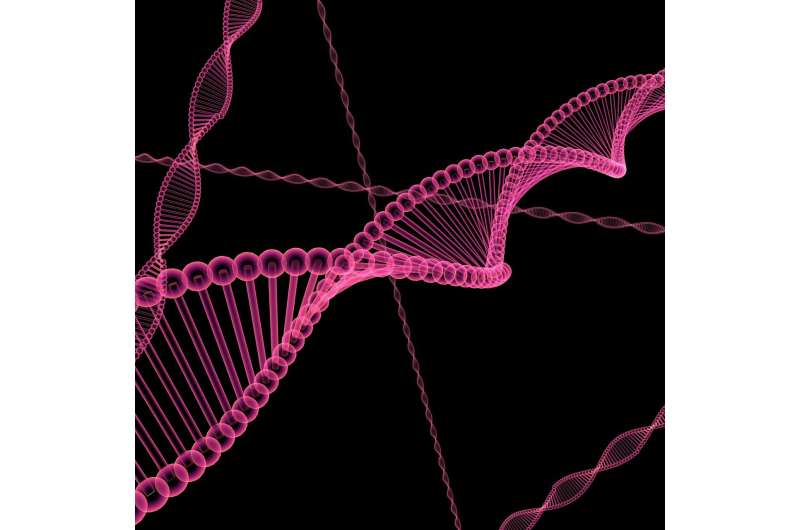This article has been reviewed according to Science X's editorial process and policies. Editors have highlighted the following attributes while ensuring the content's credibility:
fact-checked
peer-reviewed publication
trusted source
proofread
Scientists find 'key' to potential breast cancer prevention and treatment

Every time a cancer cell divides, it sustains damage to its own DNA molecules. Researchers, including Gaorav Gupta, MD, Ph.D., associate professor in the Department of Radiation Oncology at the UNC School of Medicine, have long wondered how cancers are able to evade detection by the body's own defenses, despite the immune system being on constant watch for cells displaying DNA damage.
New findings by Gupta's lab, which were published in Nature, show how the cGAS-STING pathway—a pathway inside cells essential for activating the inflammatory immune response—is unleashed to prevent cancer formation by detecting DNA damage within cells. In the process, the research team discovered the "key" that "unlocks" the cGAS/STING pathway, which is normally turned off to prevent excessive inflammation in healthy conditions.
"Our findings suggest that loss of this pathway may be what's allowing breast cancer cells to withstand high levels of DNA damage without being recognized by the immune system," said Gupta, who is also an associate professor in the Department of Biochemistry and Biophysics and member of UNC Lineberger Cancer Center. "We're very interested in identifying ways to reactivate this pathway to treat and potentially even prevent cancer development."
The key to unleashing cGAS
An enzyme called cyclic GMP-AMP synthase (cGAS) is well known for its role as a messenger for the immune system. Double-stranded DNA viruses, such as herpes simplex and chickenpox, and DNA-damaged cells are perceived as threats and waste to the body. In response, cGAS is tasked with calling on the immune system to seek out the threat and eliminate it from the body.
Back in 2020, Robert McGinty, MD, Ph.D. at the UNC Eshelman School of Pharmacy, Pengda Liu, Ph.D., and Qi Zhang, Ph.D., of the UNC Department of Biochemistry and Biophysics, were among the first research teams to make a landmark discovery about cGAS. Their paper, which was published in Science, revealed that cGAS is "locked up" in an effort to prevent the body from unleashing the inflammatory immune response unless it is absolutely necessary.
"It's in a 'turned off' state because it has a much stronger affinity for histones molecules, which are proteins around which our DNA is packaged, than to DNA itself," said Gupta. "You can think of cGAS as being locked up through its binding to histones, not able to perform its duty to recognize DNA unless it is freed by some key."
In light of his colleagues' findings, Gupta reached out to them to test a new hypothesis, using the assays they had previously developed and used in those studies.
Gupta's lab was curious to know whether a protein being investigated in his lab, MRE11, which is known to recognize broken fragments of DNA, may also be the key that releases cGAS from its histone prison. Indeed, the researchers found that MRE11, in the process of recognizing and binding to broken DNA, simultaneously releases cGAS from the histones.
"This was fascinating because MRE11 was known for detecting and repairing DNA damage, but the evidence I uncovered indicated that MRE11 plays a different role, namely in activating the innate immune system," said Min-Guk Cho, Ph.D., a postdoctoral fellow in Gupta's lab and co-first author on the paper.
The connection between inflammation and cell death
Researchers also found that when MRE11 and cGAS interact with one another, they initiate a specialized form of cell death called necroptosis. As opposed to other forms of cell death, necroptosis causes cells to die in a way that triggers immune activation, making it easier for the body to initiate an all-hands-on-deck effort.
"Linking Mre11 and cGAS to necroptosis activation is a very effective way for suppressing tumor formation," said Gupta. "When MRE11 and cGAS are activated by a damaged precancerous cell, they cooperate to activate an immune-boosting form of cell death, to help our bodies eliminate the cells before they develop into a cancer."
Future clinical treatment and collaborations
Gupta and colleagues in the UNC Lineberger Comprehensive Cancer Center are actively enrolling patients for a clinical trial at UNC to examine the combination of radiation and immunotherapy as a means of treating certain types of breast cancer.
With this new information in hand, researchers will see if the pathway is more or less responsive to these therapies, or if specific types of therapies may more effectively engage this pathway and result in improved clinical outcomes.
More information: Gaorav Gupta, MRE11 liberates cGAS from nucleosome sequestration during tumorigenesis, Nature (2024). DOI: 10.1038/s41586-023-06889-6. www.nature.com/articles/s41586-023-06889-6



















